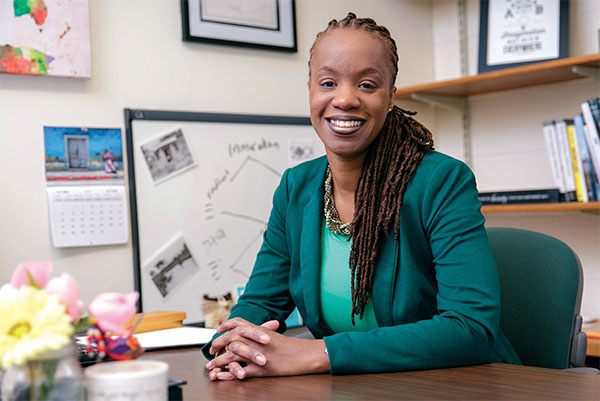“Society is on the verge of something that we haven’t seen before, and this is where Babson students become interested, creatively imagining new opportunities,” says Jennifer Bailey, assistant professor of technology and operations management.
Bailey is talking about the Internet of Things (IoT), the ability of devices to use the world’s largest network to collect and share data. Innovative minds will no doubt employ the IoT when developing solutions to some of the world’s toughest technological and business challenges, notes Bailey. But Babson wants its students to go one step further. “Where are the market opportunities, but also what is the social responsibility that comes with this?” she says.

Photo: Paige Brown
Jennifer Bailey, faculty director, Internet of Things for Good Lab
To that end, last fall The Lewis Institute, with a three-year grant from Verizon, created the IoT for Good Lab and appointed Bailey its faculty director. At the lab’s core is the course “Integrated Product Design,” which brings together students from Babson, Olin College of Engineering, and the Massachusetts College of Art and Design to learn about product development. Professors from the three colleges, including Bailey, teach the class, which rotates among the campuses. “One of the tenets of the lab is that new ideas come at the intersection of different points of view. Designers often think about the user, engineers about the technology, and business people about how to make this economically sustainable,” says Bailey.
The class focuses on the IoT and social innovation; students who took the class last fall were asked to design smart, connected products for inclusive communities using the IoT. One project, for example, centered on smart wristbands for women runners that will alert them to potential dangers on their routes. Another group worked on an emotional-wellness monitoring system for colleges that would help students understand how various communities around campus were feeling while raising awareness of mental-health issues.
Cynthia Yong ’19 worked on the system monitoring emotional wellness. “It was interesting to see the difference in perspectives of students from the other schools. It changes how you think about things,” she says. “Also, people oftentimes say designing under constraints is hard, but it’s good as well because it forces you to think outside of the box and create good design.”
The students also presented their projects to Verizon and visited its Innovation Center in Waltham. “It was inspiring to see the designs they were working on,” says Yong, “and it was interesting to hear their insights about our projects.” Yong’s team used the feedback to focus their final product on creating awareness of emotions, she says, rather than improving mental health.
Bailey says the lab is built on three pillars: inspire, ideate, and initiate. “People who have never before thought of social innovation or the IoT or these two things together—we want to inspire them to think about how the two can connect. Then, now that you’re inspired, let’s think about new ideas,” she says. “And the last thing would be initiate, or how can we start to move some of these ideas forward.”
Future plans for the lab include continuing support for coursework as well as providing seed funds and partnerships with Verizon to social innovators using the IoT. “People see the world very differently,” Bailey says. “How do you come together in a way that’s meaningful? Is social innovation technology driven? If not, why not? We’re eager to be part of the conversation and do something different.”—Donna Coco
